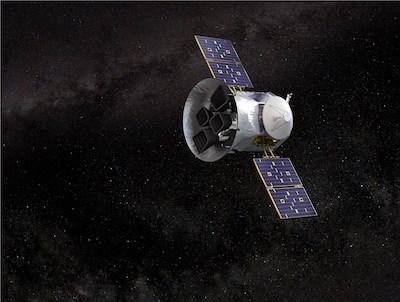Size Is Estimated To Be Between That Of Earth And Mars
NASA’s Transiting Exoplanet Survey Satellite (TESS) has discovered a world between the sizes of Mars and Earth orbiting a bright, cool, nearby star. The planet, called L 98-59b, marks the tiniest discovered by TESS to date.

Two other worlds orbit the same star. While all three planets’ sizes are known, further study with other telescopes will be needed to determine if they have atmospheres and, if so, which gases are present. The L 98-59 worlds nearly double the number of small exoplanets — that is, planets beyond our solar system — that have the best potential for this kind of follow-up.
“The discovery is a great engineering and scientific accomplishment for TESS,” said Veselin Kostov, an astrophysicist at NASA’s Goddard Space Flight Center in Greenbelt, Maryland, and the SETI Institute in Mountain View, California. “For atmospheric studies of small planets, you need short orbits around bright stars, but such planets are difficult to detect. This system has the potential for fascinating future studies.”
A paper on the findings, led by Kostov, was published in the June 27 issue of The Astronomical Journal and is now available online.
L 98-59b is around 80% Earth’s size and about 10% smaller than the previous record holder discovered by TESS. Its host star, L 98-59, is an M dwarf about one-third the mass of the Sun and lies about 35 light-years away in the southern constellation Volans. While L 98-59b is a record for TESS, even smaller planets have been discovered in data collected by NASA’s Kepler satellite, including Kepler-37b, which is only 20% larger than the Moon.
The two other worlds in the system, L 98-59c and L 98-59d, are respectively around 1.4 and 1.6 times Earth’s size. All three were discovered by TESS using transits, periodic dips in the star’s brightness caused when each planet passes in front of it.
TESS monitors one 24-by-96-degree region of the sky, called a sector, for 27 days at a time. When the satellite finishes its first year of observations in July, the L 98-59 system will have appeared in seven of the 13 sectors that make up the southern sky. Kostov’s team hopes this will allow scientists to refine what’s known about the three confirmed planets and search for additional worlds.
“If you have more than one planet orbiting in a system, they can gravitationally interact with each other,” said Jonathan Brande, a co-author and astrophysicist at Goddard and the University of Maryland, College Park. “TESS will observe L 98-59 in enough sectors that it may be able to detect planets with orbits around 100 days. But if we get really lucky, we might see the gravitational effects of undiscovered planets on the ones we currently know.”

M dwarfs like L 98-59 account for three-quarters of our Milky Way galaxy’s stellar population. But they are no larger than about half the Sun’s mass and are much cooler, with surface temperatures less than 70% of the Sun’s. Other examples include TRAPPIST-1, which hosts a system of seven Earth-size planets, and Proxima Centauri, our nearest stellar neighbor, which has one confirmed planet. Because these small, cool stars are so common, scientists want to learn more about the planetary systems that form around them.
L 98-59b, the innermost world, orbits every 2.25 days, staying so close to the star it receives as much as 22 times the amount of energy Earth receives from the Sun. The middle planet, L 98-59c, orbits every 3.7 days and experiences about 11 times as much radiation as Earth. L 98-59d, the farthest planet identified in the system so far, orbits every 7.5 days and is blasted with around four times the radiant energy as Earth.
None of the planets lie within the star’s “habitable zone,” the range of distances from the star where liquid water could exist on their surfaces. However, all of them occupy what scientists call the Venus zone, a range of stellar distances where a planet with an initial Earth-like atmosphere could experience a runaway greenhouse effect that transforms it into a Venus-like atmosphere. Based on its size, the third planet could be either a Venus-like rocky world or one more like Neptune, with a small, rocky core cocooned beneath a deep atmosphere.
One of TESS’s goals is to build a catalog of small, rocky planets on short orbits around very bright, nearby stars for atmospheric study by NASA's upcoming James Webb Space Telescope. Four of the TRAPPIST-1 worlds are prime candidates, and Kostov’s team suggests the L 98-59 planets are as well.
The TESS mission feeds our desire to understand where we came from and whether we’re alone in the universe.
"If we viewed the Sun from L 98-59, transits by Earth and Venus would lead us to think the planets are almost identical, but we know they’re not,” said Joshua Schlieder, a co-author and an astrophysicist at Goddard. “We still have many questions about why Earth became habitable and Venus did not. If we can find and study similar examples around other stars, like L 98-59, we can potentially unlock some of those secrets.”
(Images provided with NASA news release and from file)
 ANN's Daily Aero-Term (04.25.24): Airport Rotating Beacon
ANN's Daily Aero-Term (04.25.24): Airport Rotating Beacon ANN's Daily Aero-Linx (04.25.24)
ANN's Daily Aero-Linx (04.25.24) Klyde Morris (04.22.24)
Klyde Morris (04.22.24) Airborne 04.24.24: INTEGRAL E, Elixir USA, M700 RVSM
Airborne 04.24.24: INTEGRAL E, Elixir USA, M700 RVSM Airborne 04.22.24: Rotor X Worsens, Airport Fees 4 FNB?, USMC Drone Pilot
Airborne 04.22.24: Rotor X Worsens, Airport Fees 4 FNB?, USMC Drone Pilot




